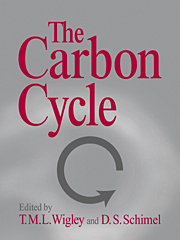Book contents
- Frontmatter
- Contents
- Preface
- Acknowledgments
- Contributors to the 1993 Global Change Institute
- I INTRODUCTION
- II THE MISSING CARBON SINK
- III PALEO-CO2 VARIATIONS
- IV MODELING CO2 CHANGES
- 14 Future Fossil Fuel Carbon Emissions without Policy Intervention: A Review
- 15 The Future Role of Reforestation in Reducing Buildup of Atmospheric CO2
- 16 Simple Ocean Carbon Cycle Models
- 17 Very High Resolution Estimates of Global Ocean Circulation, Suitable for Carbon Cycle Modeling
- 18 Effects of Ocean Circulation Change on Atmospheric CO2
- 19 Box Models of the Terrestrial Biosphere
- 20 Impacts of Climate and CO2 on the Terrestrial Carbon Cycle
- 21 Stabilization of CO2 Concentration Levels
- Part V Appendixes
- Index
17 - Very High Resolution Estimates of Global Ocean Circulation, Suitable for Carbon Cycle Modeling
from IV - MODELING CO2 CHANGES
Published online by Cambridge University Press: 04 December 2009
- Frontmatter
- Contents
- Preface
- Acknowledgments
- Contributors to the 1993 Global Change Institute
- I INTRODUCTION
- II THE MISSING CARBON SINK
- III PALEO-CO2 VARIATIONS
- IV MODELING CO2 CHANGES
- 14 Future Fossil Fuel Carbon Emissions without Policy Intervention: A Review
- 15 The Future Role of Reforestation in Reducing Buildup of Atmospheric CO2
- 16 Simple Ocean Carbon Cycle Models
- 17 Very High Resolution Estimates of Global Ocean Circulation, Suitable for Carbon Cycle Modeling
- 18 Effects of Ocean Circulation Change on Atmospheric CO2
- 19 Box Models of the Terrestrial Biosphere
- 20 Impacts of Climate and CO2 on the Terrestrial Carbon Cycle
- 21 Stabilization of CO2 Concentration Levels
- Part V Appendixes
- Index
Summary
Abstract
This chapter assesses the state of the art in modeling the physical conditions of the global ocean. Results of some new simulations are now becoming available for use by carbon cycle models for the case of modern climatic forcing. Future improvements in computer power should allow realistic physical and biogeochemical simulations for other climatic conditions, such as paleoclimates and anthropogenic climate change.
Introduction
About 10 years ago, Charles D. Keeling stopped by my office at the National Center for Atmospheric Research (NCAR) and inquired about the availability of ocean simulation fields for modeling the carbon cycle of the global ocean. I told him that, unfortunately, there was as yet no global model representation of ocean circulation that was physically realistic enough to be used for the purpose he envisioned. The global models of the time had been run for only short periods from simple initial conditions, and/or their grids were very coarse (approximately 5 degrees). I did recommend that he contact Jorge Sarmiento at the Geophysical Fluid Dynamics Laboratory (GFDL) in Princeton, New Jersey, to obtain their new modeling results for the North Atlantic, which were being produced on a relatively fine grid for that time (approximately 1 degree of latitude and longitude). Even those results had not achieved the same length scales as those for currents in the real ocean, which are typically small fractions of a degree in longitude.
Information
- Type
- Chapter
- Information
- The Carbon Cycle , pp. 212 - 228Publisher: Cambridge University PressPrint publication year: 2000
Accessibility standard: Unknown
Why this information is here
This section outlines the accessibility features of this content - including support for screen readers, full keyboard navigation and high-contrast display options. This may not be relevant for you.Accessibility Information
- 2
- Cited by
